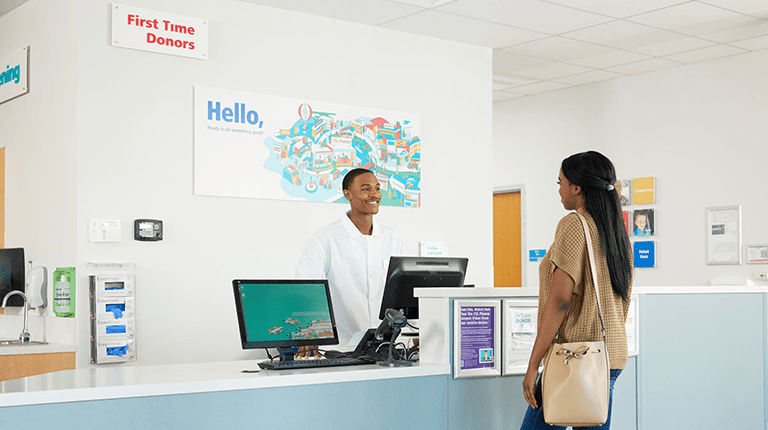The Journey of a Plasma Donation
Plasma donors hold the missing puzzle piece for those who rely on plasma-derived therapies.
Donating plasma is similar to donating blood. However, the process from plasma donation to manufacture of plasma-derived therapies (PDTs) is complex and time-intensive. Plasma collected through this process is used in the manufacture of life-saving therapies for individuals with certain life-threatening or chronic medical conditions.1
CSL Plasma rewards eligible plasma donors for their time and commitment. During the donation process, plasma is collected through plasmapheresis, a procedure that separates plasma from blood and returns the remaining blood components to the donor. Plasma contains nutrients, antibodies, and proteins essential for critical bodily functions, such as clotting and fighting infections.
For many of CSL Plasma’s donors, donating plasma is an opportunity to help others while supporting their own well-being. Claude Farmer, donor in Medford, Oregon, has been donating at CSL Plasma since 2010. When asked how it makes him feel to know his plasma benefits those in need, he shared that it:
“Makes (me) feel delighted that I can do something beneficial to myself and also to someone in need.” Claude donates plasma because “(It) helps me financially, is good to give back to those in need, those who may not have exactly what they need from their own body.”
Plasma is the liquid portion of blood that carries essential components such as proteins, antibodies, and clotting factors which support immune function, wound healing, and other critical physiological functions. In individuals with rare or chronic conditions, certain plasma proteins may be missing or not functioning properly. This can be serious and sometimes life-threatening for individuals with these conditions. It is as if a vital piece of the puzzle needed for critical blood function is missing.

Health and Safety
The process begins with the donor. Unlike other medications, plasma proteins can’t be made in a lab at the scale or complexity required for therapies. Instead, they must come from eligible healthy adults. To be eligible to donate plasma, donors must have a permanent address and must pass comprehensive health and safety screenings, which include a review of medical history and testing for transmissible viruses. On return visits, donors complete a shorter health questionnaire to ensure continued eligibility. All donated plasma undergoes rigorous safety testing at CSL’s laboratories in Göettingen, Germany or Knoxville, Tennessee. These tests screen for a range of infectious agents, including hepatitis, parvovirus and human immunodeficiency virus, or HIV.
The Plasma Donation Process
CSL operates more than 300 plasma donation centers across the United States, with additional centers in Germany and Hungary. These centers welcome new donors every day but also rely on repeat donors. In the United States the average plasma donor donates plasma up to 21 times per year, contributing to approximately 60 million liters of plasma donated in 2024.
The donation process takes approximately 35-60 minutes to complete. However, the total time may vary based on the individual donor’s health status, experience level, and other factors. During the donation process, whole blood is drawn, plasma is separated and collected, and the remaining blood components, including red blood cells, are returned to the donor.
- One donation results in approximately 21 to 36 ounces (625 to 1090 mL) of plasma, depending on the donor’s body weight and other factors.
- Because the donor’s red blood cells are returned during donation, and donors receive 500 mL of saline to help replace lost fluid, eligible plasma donors may donate plasma up to twice per week, in accordance with applicable health and regulatory guidelines.
Manufacturing Plasma-Derived Therapies
Donated plasma is held in inventory at CSL’s Plasma Logistics Centers for approximately 45-60 days before undergoing further testing and processing. Once a frozen plasma unit is shipped to CSL’s manufacturing facilities, it is tested again as part of the pooling process to verify quality and support product safety standards. During the manufacturing process, plasma proteins are separated and purified to develop a range of PDTs to treat various medical conditions.
The Difference
The process involves a multi-stage pathway, from plasma donation to the delivery of therapies, requiring significant time, resources and specialized infrastructure. Meeting patient needs and manufacturing products can take up to 12 months, much longer than the typical production timeline to produce many small molecule drugs. That is why we carefully plan plasma collection and production in line with anticipated demand and projected patient care needs.
In addition, the cost of manufacturing PDTs represents about 57% of total business costs, compared to around 14% of total business costs for traditional pharmaceuticals. Establishing and maintaining the needed plasma supply chain requires significant investment in infrastructure and technology. Each center costs an estimated $2-3 million to establish and operate.
The Patient
PDTs are used in the treatment of various medical conditions like bleeding disorders, immune deficiencies, hereditary angioedema, respiratory diseases and neurological disorders. Patients receive these products in a variety of healthcare settings, including hospitals, outpatient clinics, and even at home with proper training.
- More than 1,200 plasma donations are needed to treat one person with hemophilia for a one-year supply of medicine.2
- More than 130 plasma donations are needed to treat one person with a primary immune deficiency for one-year supply of medicine.1
A plasma journey starts and ends with a single person – the donor and the patient
Every step in the plasma journey reflects a deeply embedded and stringent framework for quality and safety, and CSL Plasma holds the utmost respect for both the life-changing potential of donated plasma, and the donors who choose to donate.
1 This content is for informational purposes only and is not intended as medical advice. Individuals should consult with a healthcare provider before making decisions related to health or plasma donation. All donor stories shared with permission. Donor eligibility is determined by health screening and regulatory guidelines.
2 Source: Plasma Protein Therapeutics Association


